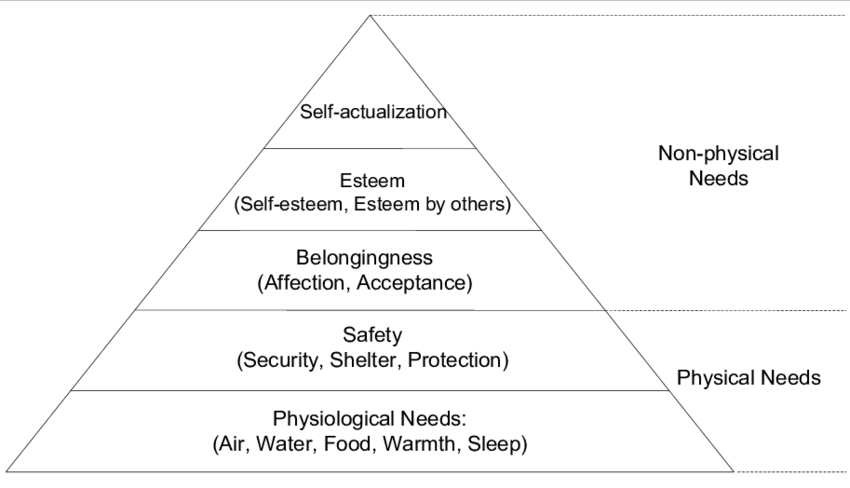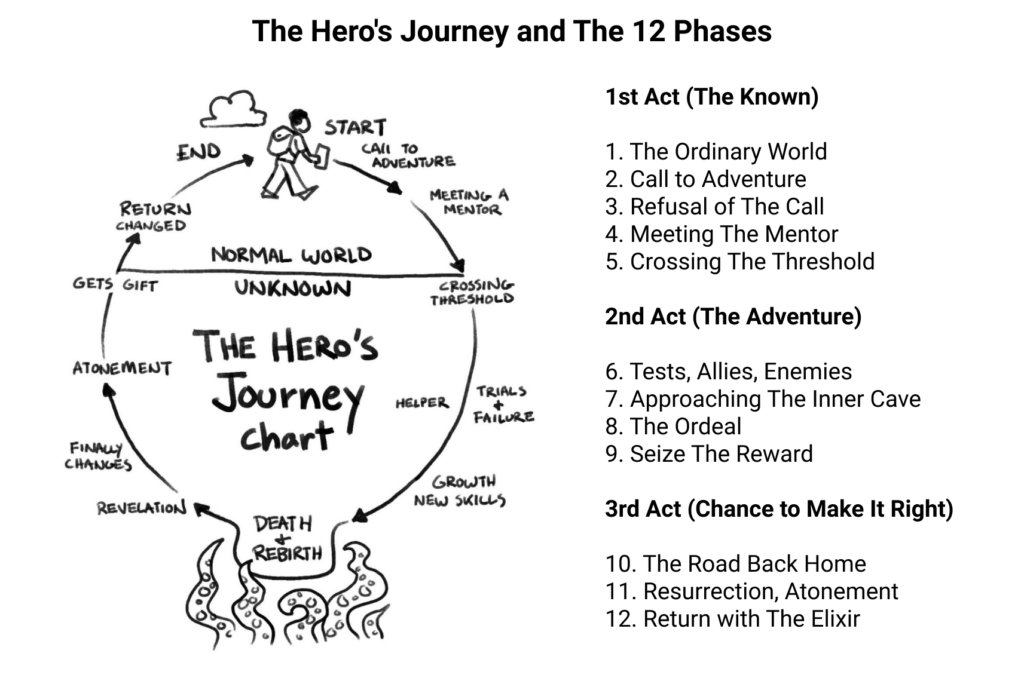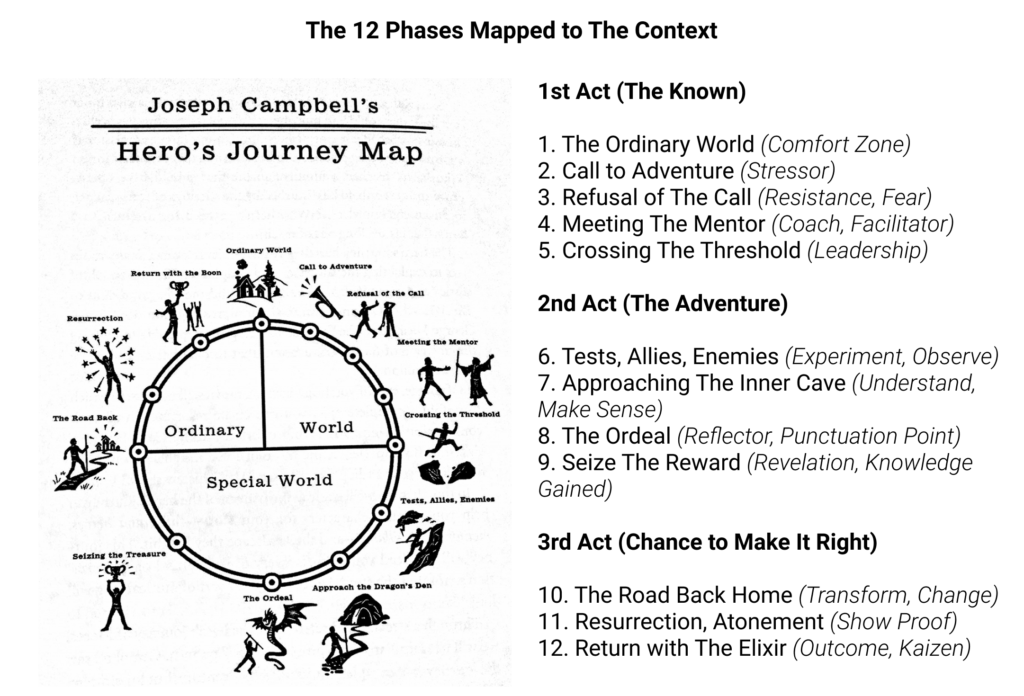This article consists of 2 parts on how I apply the concept of Hero's Journey to Evolutionary Change Management.
In this first part, I would like to set the ground by sharing the mental model that helped me communicate better with organizational leaders when managing evolutionary change.
Journey to the Unknown Is Always Uncomfortable
We, humans, fear the unknown. In any situation where a decision is needed to be made, safety and well-being take top priority.
Before any journey into the unknown, it would be nice to get as much information as possible and make an effort to understand it as best as one can. People need to feel safe/prepared/illuminated -physically and/or mentally- for what lies ahead before taking that first step forward.
Journeys change cultures, and they are necessary to evolve for the better. It is understandable that people react to change with some degree of resistance. Because change is personal. No one wants to go into a dark alley and get beaten up. They might be forced to do it once, but there won't be a second time, at least without an assurance. Physical and psychological safety is important.
 Maslow's Hierarchy of Needs. Image credit: researchgate.net
Maslow's Hierarchy of Needs. Image credit: researchgate.net
This is where you - the mentor, the coach, the one who has been there-, step in to share your knowledge and facilitate the flow, so the psychological safety is there. With that, the journey becomes a fruitful one. People try new things and learn when they feel safe.
Remember, your job is to illuminate the canvas so a path can be decided by the people who will take on the journey. Otherwise, it is your journey and not theirs. There will be no ownership. No thinking creature travels on a path that doesn't lead to where they want.
With all these; uncertainty, risk, doubt, and fear of the unknown, how do you:
- unite people on a shared purpose?
- motivate them to take on a leadership role?
- help them take the first step forward and own it?
- try new ways of working and learn from the experience?
That is what I am going to write about in this article. I'll elaborate on how I use Joseph Campbell's Hero's Journey as one of my coaching tools in organizational transformations at any level, from CXOs to teams.
The Hero's Journey
"The cave you fear to enter holds the treasure you seek." -- Joseph Campbell
Joseph John Campbell (March 26, 1904 - October 30, 1987) was an American professor of literature at Sarah Lawrence College who worked in comparative mythology and comparative religion. His work covers many aspects of the human experience. Campbell's most well-known work is his book The Hero with a Thousand Faces (1949), in which he discusses his theory of the journey of the archetypal hero shared by world mythologies, termed the monomyth.[1]
Joseph Campbell found out that for thousands of years, people all over the world communicated with stories having similar patterns and basic elements. He structured these patterns and elements into 12 phases and called it "The Hero's Journey". These stages incorporate mechanisms that connect people on a deeper, core level. It is in our DNA.
"In essence, [Hero's Journey] taps into our innate human desire to become better versions of ourselves. It gives us a sense that real, meaningful transformation is possible. It shows us that we can become stronger, overcome our inner and outer obstacles, and win the day."[2]

No wonder this technique is so popular in Hollywood. You can find the 12 phases of Hero's Journey in almost all of the movies. George Lucas, for example, credited Campbell's work as influencing his Star Wars saga.[3] Peter Jackson incorporated his ideas too in the creation of The Lord of The Rings trilogy. This is what I will use as an example.
We Live in a World Driven by Narrative
People love stories. Remember bedtime stories our parents told us? Those are valuable times for both parents and kids. Parents get to teach morality lessons and kids have a good time while learning through stories, and vice versa.
Sometimes it is not that easy. It might be challenging for some parents to have their kids listen to what they have to say, let alone lecture them in bed. Because during bedtime most kids are in reduced capability, tired, grumpy, and (with that last adrenalin rush) maybe hyper-active. With all these, they will resist cooperating.
Here is where bedtime stories come into play to make cooperation happen. Listening to stories in bed is intriguing to kids; I can't think of anyone who wouldn't like a story and imagine themselves in whatever magical world is being depicted.
Things are not that different in grown-up life either.
So, what is common between a bunch of grumpy bedtime kids and organizations on the brink of change? Let me tell you, it is the "resistance" and here is more:
- They [team members, managers, leaders, etc.] are tired/frustrated.
- They do not want to cooperate/reason with you.
- They, probably, want to avoid you in any way they could.
- They just want to keep doing what they want to do.
A culture in laziness; not willing to leave the comfort zone, can be exploited by powerful narratives.
During these uneasy times, how would one start an adult-to-adult conversation, understand what is wanted, and come to terms on what is actually needed?
Hint: with a nice story. After all, a powerful storyteller can dismiss inconveniences of the real world and make any bitter truth that needs to be heard fascinating.
What I am writing about here is not some brainwashing technique that will enable you to command organizations at your will, but instead open a two-way communication channel (an adult-to-adult feedback loop) that works even when people are grumpy/resistive. This technique makes it possible to:
- hear each other out and decide what is needed,
- understand the risks in this journey, and
- agree on a shared outcome even before starting to change anything. #Respect #StartWithWhatYouDoNow
I've come up with the idea of using storification powered by Hero's Journey after a quite challenging C-level meeting. I've come to the conclusion that being a powerful narrator was just enough to keep people's attention for a short while.
A good story plot is as important as a powerful narrator who tells it.
Making them focus for longer and keep them engaged at the same time needed a good plot. A plot as a storyline filled with dragons and heroes that listeners can relate to, and with a magnificent ending; heroes seizing the moment.
To make a difference, have them listen to each other. To have attention, help them relate to the subject.
It would be even greater if that plot is drawn by the listeners/leaders/heroes themselves. Let them write their own story and prepare for their journey, together.
They should relate to one another, share the vision and purpose, plan their needs one at a time. Then create the time-line, know the time-line, own the roles, have responsibilities, and be ready when the cue is received.
An Evolutionary Change Management Tool
Psychological safety -Maslow's Hierarchy of Needs-, journeys, stories, narratives, myths, nations, heroes, C-levels, transformations, coaching... all these boil down to this section; how to make it relevant to the context of evolutionary change management.
Well, I was looking for some kind of a vessel to relay my messages to C-levels, about organizational transformation, while keeping their attention longer than they used to and actually make them see what they are getting into. I was looking for a way to have them own it.
After reading about Joseph Campbell's Hero's Journey, this is what I had:
- Some thousand-year-old proven communication technique, check.
- Has culture-proof norms which are accepted all over the world, check.
- Has content suitable for all ages; friends and foes, dragons and treasures, check.
- Used for bragging about one's transformation in a legendary way -hello Celebrity Effect-, check.
- Specifically involves a mentor/coach, check.
The 12 Phases Mapped to the Context
I asked myself "Seriously, what can I ask for more!", then more showed up; look at the 12 phases that have been described. It does look familiar! As soon as I saw them, I was mapping the phases into my context.
 Source: Winning the Story Wars. Image credit: https://www.philipruddytherapy.com
Source: Winning the Story Wars. Image credit: https://www.philipruddytherapy.com
1st Act (The Known)
1. The Ordinary World (Comfort Zone)
Here, all's right with the world. We are sipping our drinks, partying, and enjoying the scenery (The shire | Our organization).
2. Call to Adventure (Stressor)
An irreversible event happens; a relic has been surfaced (ring | mindset) and demand for it is high (Nazgüls | competition). We've been asked to deliver it.
3. Refusal of The Call (Resistance, Fear)
The first pass at the challenge proved not easy. We almost or completely failed to deliver (stabbed by a Morgul blade | resistance from the culture), we gave up.
4. Meeting The Mentor (Coach, Facilitator)
From the (wizard | coach), we learn the risks and why no to give up (save Middle Earth | humane ways of working). Now it's up to us to do something about it. [4]
5. Crossing The Threshold (Leadership | 1st Threshold)
A handshake is made (humans, dwarfs, elves | managers, leaders, teams). We are given artifacts (orc-sensing blade, impenetrable armor, a bottle of light | empowerment, right to fail, frameworks) to increase our safety in this journey.
2nd Act (The Adventure)
6. Tests, Allies, Enemies (Experiment, Observe)
From one unknown to another, we try our ways, first, to get what we want (Boromir, Gollum | multi-tasking, dependencies, manage people). We don't change right away but the journey changes us as it sees fit; fit for purpose.
7. Approaching The Inner Cave (Understand, Make Sense)
We observe, probe, and make sense of our new environment. When an old fails, a new is learned. Pragmatic approach (keep what works) is survival. We start to evolve. (Manage and limit work, see services, visualize, flow)
8. The Ordeal (Reflector, Punctuation Point | 2nd Threshold)
While enduring the journey, a powerful secret about ourselves is discovered. And it almost killed us (realizing Gollum is the enemy, Sam is the ally, while trapped in the lair of Shelob | Blindly following a framework is not the goal but achieving a shared outcome together is).
9. Seize The Reward (Revelation, Knowledge Gained | 1st Exit Point)
The ordeal revealed to us what we needed and it's usually not what we wanted. Either accept this bitter knowledge and do something about it or give up. Revelation happens (Sam is a true friend and the ring must be destroyed by Frodo / a new mindset, guiding principles, the why/purpose must be embraced ).
This is the point where we start to change. Up to this point, we have been our old selves playing with new tools.
3rd Act (Chance to Make It Right)
10. The Road Back Home (Transform, Change)
Now make it right by doing what needs to be done with the gained knowledge. We start transforming to keep up with the journey and bring home the prize (Sam carrying Frodo to Mount Doom | A humane way to work, evolve for better).
11. Resurrection, Atonement (Show Proof | 2nd Exit Point)
Now we have unmistakable proof that change happened, the outcome is achieved. We have been reborn from our ashes. ( Frodo and Sam rejoice and they are honored by their fellow heroes | First pilot proves successful)
12. Return with The Elixir (Outcome, Kaizen)
Now we return with the reward/knowledge and the journey ends with us being recognized in our home (At Aragorn's coronation the new king kneels to Hobbits and says "You bow to no one!" | Being recognized at a company event or by a published paper). Kaizen achieved, another journey may begin.
The Mental Model Conclusion
In this part of the article, I've been sharing the mental model of Hero's Journey in the context of Evolutionary Change Management. In the second part, I'll explain how I implement this mental model into my coaching style through a workshop.
I'll explain how I structure and present this mental model during the first meeting with the client, how to keep the findings on the board and update it frequently to communicate the transformation progress with the rest of the organization.
Reference List
- Joseph Campbell. (n.d.). In Wikipedia. Retrieved April 21, 2020, from https://en.wikipedia.org/wiki/Joseph_Campbell
- Understanding the Hero's Journey: A Crash Course for Filmmakers. (n.d.). Retrieved April 21, 2020, from https://blog.storyfirst.com/storytelling-101/the-heros-journey/
- Sentence was influenced by the Kanban "blue" book (by David J. Anderson) cover. The leadership words: let's do something about it.

Alper Tonga
Guest Author
Alper Tonga is an Agility Coach at Adidas Runtastic. He is a Kanban University-certified Kanban Coaching Professional and Accredited Kanban Trainer. He is one of the partners in the Agendashift community and a public speaker from Turkey. For the past 8 years, he's led more than 10 organizational transformation journeys worldwide in different companies that do business in banking, telecom, retail.



